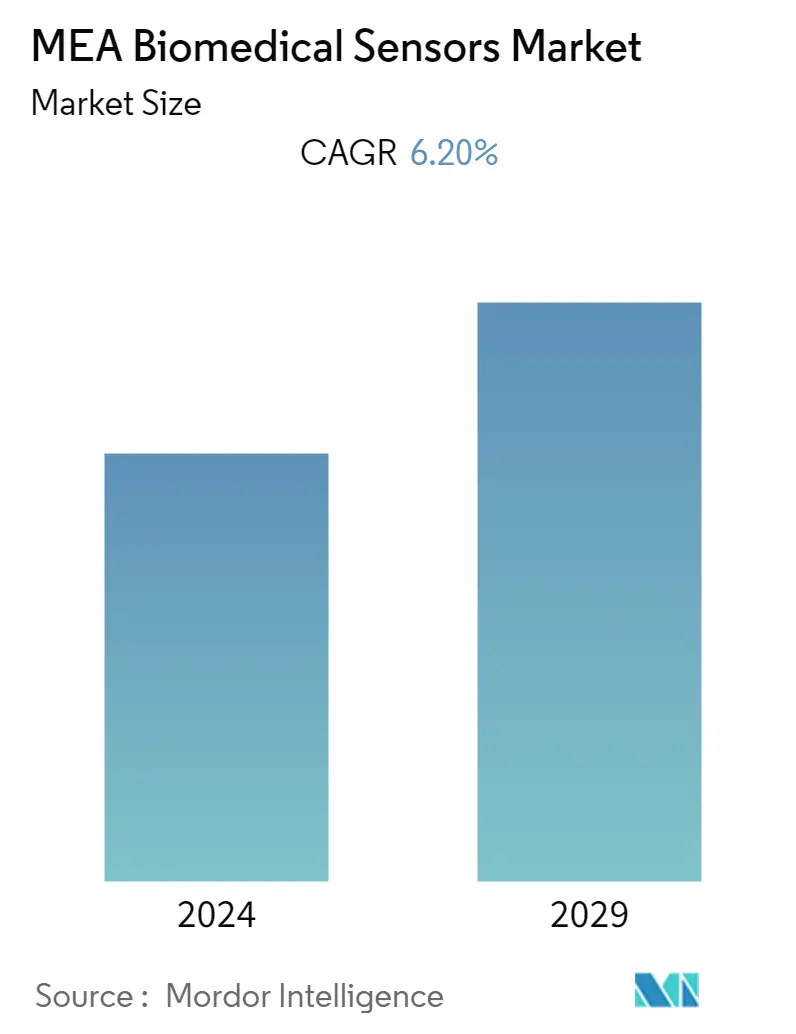Market Size of MEA Biomedical Sensors Industry

| Study Period | 2019 - 2029 |
| Base Year For Estimation | 2023 |
| Forecast Data Period | 2024 - 2029 |
| Historical Data Period | 2019 - 2022 |
| CAGR | 6.20 % |
| Market Concentration | Low |
Major Players
*Disclaimer: Major Players sorted in no particular order |
Need a report that reflects how COVID-19 has impacted this market and its growth?
MEA Biomedical Sensors Market Analysis
The Middle East and Africa Biomedical Sensors market is estimated at USD 380 million by 2027 at a CAGR of 6.2% over the period 2022-2027. The near future will bring Biomedical sensors that are adaptable to the genetic formulation of each individual. These sensors can be set to trigger alerts when unpredictable readings are enlisted, screen the existence of toxic agents in the blood, or empower drugs directly into the circulatory system. These Sensors are set to find their demand in the healthcare industry.
- Biomedical Sensors are driven by the increased demand in hazardous environments, utilization in situations resulting from natural disasters, increased demand in the healthcare sector for diabetic and heart patients, and embedded monitoring of the patients. The advancement in technology has made it possible to build a Biomedical Sensor using Nano and Microtechnology, making it tiny, robust, smart, and cost-effective. The early detection of irregularities in the health status of the patients will contribute to a better quality of life.
- Even though Biomedical Sensors are playing a major role in the life-saving situation, it is facing certain challenges such as patient's safety and comfort due to strong electromagnetic fields, transferring energy from external to internal parts with high efficiency and high data rates, limited computation, and data storage, and ultra-low power consumption. UAE is leading the market and also with the highest growth rate in this region, followed by Saudi Arabia and Israel.
- Antimicrobial resistance, poor lifestyles, alcohol consumption, and smoking all contribute to the increased prevalence of lifestyle-related disorders, including diabetes. According to the International Diabetes Federation, 463 million persons had diabetes in 2019, with 700 million projected by 2045. As a result, the demand for biomedical sensors for routine health monitoring is growing. Furthermore, cardiovascular diseases (CVD) constitute a serious threat to human health and place a considerable financial burden on both developed and developing countries around the world.
- COVID has had a significant impact on countries like Saudi Arabia and the United Arab Emirates, with an estimated 0.733 million overall cases in the area, according to the John Hopkins Institute. According to Worldometer data, South Africa had about 1.51 million COVID-19 positive cases as of March 1, 2021. Countries are experiencing economic crises, which are affecting a variety of industries, including healthcare. Despite this, the market for biological sensors is growing due to the significant rise in COVID-19 detection tests. As a result, numerous technologies for quick testing have been created. For example, researchers from Riyadh's Alfaisal University partnered with Riyadh's King Abdullah International Medical Research Center to develop biomedical sensors to detect the Middle East respiratory syndrome coronavirus (MERS).
